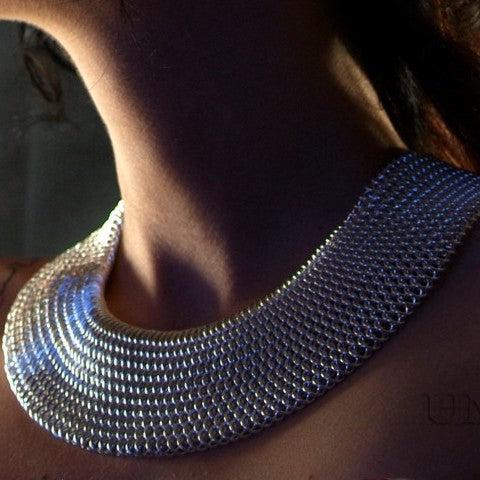When I began developing this project, it was my intention to graduate this collar, similarly to my European 4-in-1 Collar. But as I came to really know Dragonscale, I realized that graduation isn't necessary to get this perfect curve, it's simply a characteristic native to the weave. It was also my intention to make a kit of this project but when I realized it would be just a simple strip of Dragonscale with nothing fancy required to make that perfect curve, I decided to post it here as a free project idea so all you'll need to make this collar is the rings and a clasp and knowledge of Dragonscale, everything else is on this page.
Since we don't yet have a kit to teach Dragonscale, I recommend choosing from among the many free tutorials available online, while using our ring size recommendations for best results. In addition to flex, which is the inside diameter of the smallest circle into which a given chain can be curled, Dragonscale can also be measured for fan, the inside diameter of the smallest circle into which a given chain can be fanned. That measurement is determined by the sizes of rings used, of course, but also by the width of the chain.
There are countless possible combinations and you might want to do some experimenting of your own but for this project, the rings are 18g/6.0mm and 18g/3.75mm sterling. All the other sterlings should work out the same but I'm not sure about copper or any combination of copper and sterling. There are 5 columns in the chain, the flex is about 1 inch and the fan is about 4 inches. In other words, this collar will fan into a circle with an inside diameter of no smaller than 4" across.
A fan diameter of 4" will fit a neck as small as 12.5" around. To make a smaller fan, you'd have to go with fewer rows with a narrower collar resulting. The collar can be made wider with more rows if the inside diameter of the fanned circle can be larger but experimentation will be required to work out the ratios.
To determine how many rings to order, enter the neck measurement into the circumference box in
http://math.about.com/library/blcirclecalculator.htm
this calculator and click Solve Others to get the inside diameter of the fanned circle you'll need to make.
For example, a 16 inch neck measurement equals a fanned circle with a 5 inch inside diameter. Because the collar is wide, it requires extra length to lay flat. Add two inches to the diameter shown in the calculator and click Solve Others to see the actual length of chain you'll need to make. Using the example above, the diameter shown in the calculator is changed from 5 inches to 7 inches, recalculated, and the resulting circumference shown is almost 22 inches.
Example for 13 inch neck.
First, take the circumference of the neck and find the diameter using the formula:
d = c/π
d = diameter (distance from circle center to edge)
c = circumference (neck size)
π = pi (3.1415)
d = 13 / 3.1415 = 4.13 inches
Now we add the necklace width to the diameter to figure out the distance from the center of the neck to the outside edge.
4.13 + 1.25 = 5.4 inches
And now, we just reverse the formula and figure out the outside circumference from the diameter using the formula:
c = πd
c = 3.1415 x 5.4 = 16.96 inches
This collar is 1.75 inches wide, there are 14 rows per inch of length and 5 rings of each size per row for a total of 70 rings per inch needed in each of the two recommended ring sizes. To make the 22 inch chain needed to fit a 16 inch neck, multiply 70 rings by 22 inches to see that 1540 rings of each of the two ring sizes will be needed. In sterling, that's 6.3ozt of 18g/3.75mm and 9.2ozt of 18g/6.0mm. As you can see, this is a weighty and luxurious collar when made in a full circle. To reduce overall weight, you might choose to weave a partial circle completed with a length of (sturdy) chain at the back, narrow the collar's width, or both. This is a design concept with a lot of room for taking off in your own direction.
I've yet to find the perfect clasp for this collar. A slide clasp would work beautifully, if the spacing is right on the clasp rings and the ends are angled to meet nicely. Another option is to use a hook and eye clasp with a chain, attached at the top of the collar in back. That could be particularly effective with a dangle of some sort hanging at the back of the neck. If you come up with a clasp solution you love, I hope you'll share it with us.





